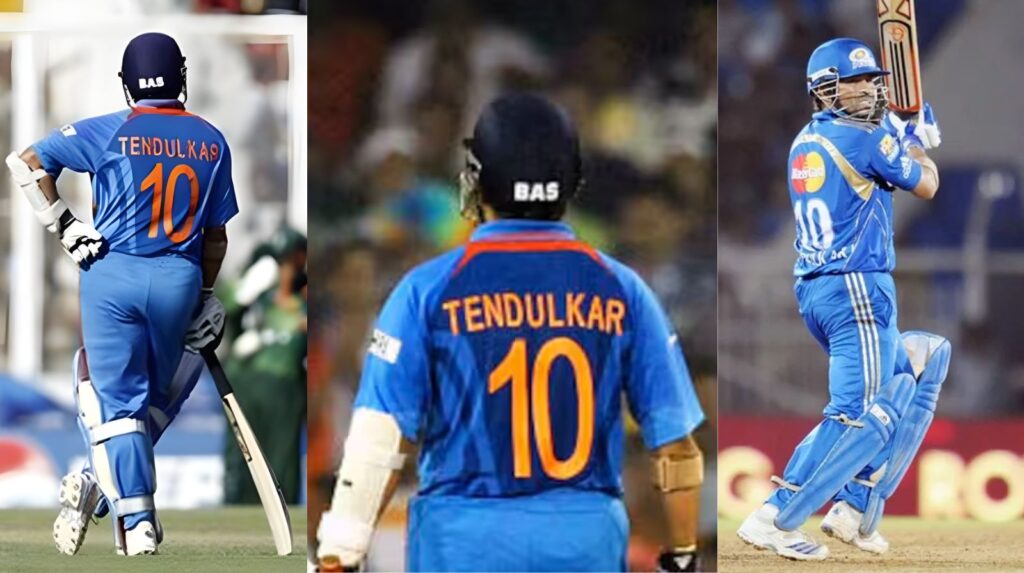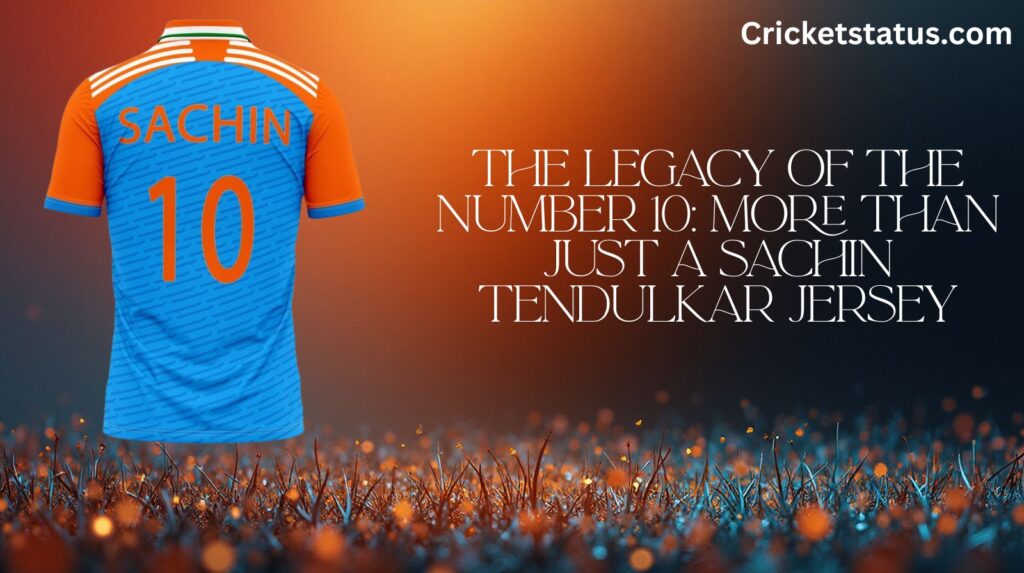Sachin Tendulkar Jersey: Across the pantheon of international sport, numbers take on a meaning that transcends mere mathematical value. In basketball, there is Michael Jordan’s 23. In football, you have Diego Maradona’s No. And in the world of cricket, that magic number is undoubtedly 10 – inseparable from its one true wearer: Sachin Ramesh Tendulkar. For more than 20 years, as one billion hopes pinned on his shoulders, there was comfort in that flash of blue (or white) with the number 10 at the back for a nation — hope, inspiration and unfailing belief. However, more than just being a number, the tale of Sachin’s jersey number has become an inseparable part of Indian cricketing folklore; a digit that symbolizes records, emotions and history.
The Unassuming Origin: Why Number 10?
Unlike many contemporary athletes who meticulously manage their image around a magnum number, Sachin Tendulkar was not obsessed by the digits for any major personal reason or superstition. During the yesteryears of his career, more so in ODIs, numbers on jerseys used to been assigned according to a player’s batting position.
The Batting Order Theory
The general reasoning behind it is that Sachin was used to play at the top of the order in ODIs, and 10 was a logical number after 1 (if one reads from left to right). This small, administrative decision — from some team manager in the early 1990s would evolve into one of the most famous brands in sports. It was a convenience that through pure brilliance and longevity had become the stuff of legend.
The Lack of Superstition
Sachin has been quoted saying he is not very superstitious. His success was based on hard work, flawless technique and a ferocious competitive drive, not on good luck charms or numerology. It gives the number 10’s legacy even more strength — it was not passed along on sheer predetermined mystique, but solely in blood and sweat and runs of man who bore it.
The Evolution of an Icon: From Jersey to Symbol
The 10 mutated as Sachin’s career wore on. It was no longer just a number in a uniform; it became an emblem.
The Persona of “Tendulkar 10”
The “Tendulkar 10” had been crafted into an integrated brand. It was on jerseys, cricket bats, posters and memorabilia. For fans, it was a badge of loyalty. It was a dream for youngwould be cricketers. The number became so much a part of him that you could use it interchangeably with his name. Commentators would cry: “And the No.10 is walking out to the middle! and everyone knew who it was. It was a seal of quality, an assurance of entertainment, the figurehead for all cricketing prowess.
A Nation’s Emotional Anchor
The fate of the Indian cricket team in the `90s and 2000s was a bit like this. The sole constant was Sachin Tendulkar. On myriad days when the rest of the order seemed to be overreaching itself, there was no thing in sight at one end but a number 10 clinging on for dear life and holding a nation’s nerve. The figure became a sort of emotional keel — a handle on resilience and hope. It was the shield against despair, also a sword with which he slaughtered bowling attacks. The emotional bond created between the Indian public and that modest two-digit figure is probably unparalleled in the history of sport.
Read More: Australian Men’s Cricket Team vs India National Cricket Team Timeline
The Number 10 in a Global Context

As a way of gauging the significance of wearing Sachin’s No 10, look no further than if you were to put it in perspective against other iconic numbers across sports.
A Comparative Look at Iconic Sports Numbers
| Sport | Iconic Number | Associated Legend | Reason for Fame |
|---|---|---|---|
| Football (Soccer) | 10 | Pelé, Maradona, Messi | Traditionally the playmaker, the team’s creative engine. |
| Basketball (NBA) | 23 | Michael Jordan | A self-chosen number; became a global symbol of athletic dominance. |
| Cricket (India) | 10 | Sachin Tendulkar | Assigned initially, but defined by 24 years of record-shattering performance. |
| Rugby Union | 10 | Jonny Wilkinson, Dan Carter | The fly-half, the strategic controller and primary kicker. |
| Ice Hockey | 99 | Wayne Gretzky | Chosen as a child; retired league-wide in his honor. |
The table makes a point. Where the likes of 10 in football or 23 in basketball are iconic for several players, Indian cricket has just one true owner of the number. It’s not a job-based count, but a person-based one.
The Post-Retirement Legacy: A Retired Icon
The final bow of this bond was evident after Sachin decided to hang his boots. BCCI went for an unprecedented emotional decision by retiring the Indian jersey number 10 from all forms of international cricket.
An Honor Bestowed
This was not an NHL 99, the kind that Wayne Gretzky wore and even had retired leaguewide in his honor. It was a deeply generous gesture from the Indian cricket board. It means no other Indian cricketer will ever again don the number 10 for its national side. This choice enshrines the number so that in the history of Indian cricket, 10 will forever speak a Sachin Tendulkar story.
The Weight on Successors
Although the number is retired at national-team level, it’s still employed in domestic T20 leagues such as the IPL. Evin Lewis, Travis Head have been some of the players who wore it for their respective franchises. But wearing a “Tendulkar 10” for Mumbai Indians, the franchise that he had skippered, brings its own big pressure and expectation, a constant reminder of the huge shadow under which they are playing.
Read More: Delhi Capitals vs Gujarat Titans Timeline
Conclusion
Sachin Tendulkar is a case study of how meaning is created through doing. It began as an administrative afterthought, a number bestowed unceremoniously. But over the course of 24 years, 100 international centuries, 34,000 runs and a nation’s affection it became instead an emblem that was sacred. It is a number that summons memories of straight drives, uppercuts for six and modest celebrations with bat raised. It is a legacy of excellence, humility and passion that moved a generation. No longer just a number, the 10 is now bighouse that stands as monument to the man who became religion and an indelible part of cricket’s rich tapestry.
FAQs About Sachin Tendulkar Jersey
Q1: Why did Sachin Tendulkar select the 10 number?
A1: Well Sachin did not choose 10, himself. It was probably given to him by the team management when he first started playing ODIs, possibly because he was an opening batsman (batting position 1) and 10 is the reverse of that.
Q2: Is the Indian cricket jersey number 10 retired?
A2: Yes. The BCCI retired the number 10 jersey in ODI’s as a mark of respect to the cricketing legend during his farewell on 18 October 2013. It will never be worn again by any Indian cricketer in the national team.
Q3: It is being worn by another cricketer at all?
A3: While it is retired on the Indian national team, other international cricketers, and players in domestic T20 leagues like IPL can indeed wear the number 10. Eg it has been seen players in the Mumbai Indians team wearing this after retirement of Sachin.
Q4: How does the number 10 apply to other sports?
A4: The 10 is a classic number in football (soccer), representing the team’s playmaker and most creative attacker.It has been worn by legendary players such as Pelé, Maradona, Messi and others.
Q5: Did Sachin Tendulkar have any superstitions over his shirt number?
A5: As per all accounts, Sachin wasn’t a superstitious player. But he achieved it through hard work and dedication not a superstition of luck what came from his jersey. The number meant nothing — it was all what he did with how many times per game.



